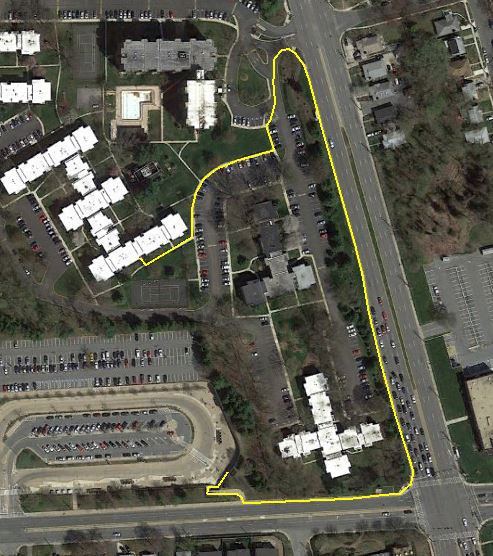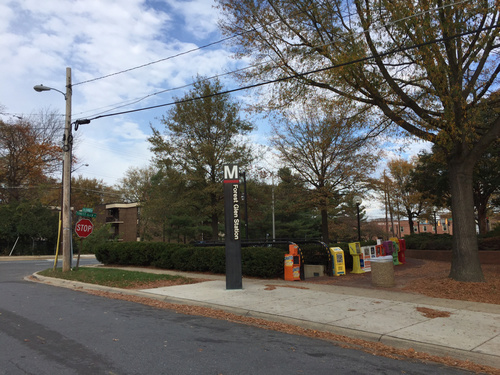A chain-link fence is blocking people from getting to the Forest Glen Metro
You’d think residents of a building full of apartments and condos right next to the Forest Glen Metro would have an easy time getting to the station. But a chain-linked, barbed-wire fence means they have to take a circuitous route to the station. Is it time to tear the fence down?

Photo by the author.
First built in 1967, the Americana Finnmark complex originally included a seven-story mid-rise building. Four garden-styled condo buildings joined it in 1974.
Conveniently located on Georgia Avenue at Forest Glen Road, just before the I-495 ramp, American Finnmark has housing that’s attractive to a lot of people, with moderate prices and a park-like setting with tot lots, a dog run, picnic areas including grills, a large pool, toddler pool, tennis and basketball courts. It’s also got ample parking.
But because of the fence where American Finnmark borders the Metro station, there is no direct access despite being just a few hundred feet from the main entrance.

Aerial view of Americana Finnmark and Forest Glen Metro. The fence runs along the tree line that’s north of the parking lot and south of the tennis courts. Base image from Bing Maps.
As a result, many Americana Finnmark residents have to walk around the perimeter of the complex and onto Georgia Avenue before trekking down Forest Glen Road to the Metro entrance.

The typical walk from Americana Finnmark to Forest Glen Metro. Base image from Google Maps, drawing by Sean Emerson.
Illustrated by the yellow line on the above map, the path to the main Metro entrance around the fence is approximately .41 miles, or 2,150 feet. Because of the shorter distance, many residents instead use the secondary metro entrance at Forest Glen Rd and Coleridge Dr.

Photo by the author..
In order to get to this more convenient Metro entrance, many Americana Finnmark residents have to cross a dangerous intersection, where they battle drivers eager to get on I-495 and Georgia Avenue. If a pedestrian pathway replaced the fence, Americana Finnmark residents would only have to walk a mere .09 miles, or 480 feet, to get to the Metro entrance and there would also be no need for the shortcut across Forest Glen Road.
Unlike the Forest Glen Metro station, other Metro stations in the region are surrounded by residential and commercial complexes that flow directly into them. Communities like Virginia Square in Arlington have opened up their apartments and condos to the Metro, creating a natural flow where residences seamlessly integrate into commercial, retail and transit spaces.
According to land records, WMATA owns the fence separating the station from the Americana Finnmark. It’s likely that the fence went up at a time when Metro stations were largely associated with crime. With the mass exodus of white families from DC into the surrounding areas, many saw Metro as a vehicle for bad actors. The fence could have provided a certain level of assurance that properties would be safe from such individuals.

Land records showing Property Ownership. Image from Montgomery County.
But those worries aren’t very common today. Instead, properties close to mass transit are the most desirable in the country. With developers building around Metro stations more than ever, now could be the time to ask whether we need such a “security” fence. Without the barrier, Americana Finnmark’s significant population could not only patronize any new retail at the station, but also could take advantage of any other redevelopment that might happen at the Forest Glen Metro.
There’s tons of potential to create a new dynamic space for the community. Let’s lose the fence.

